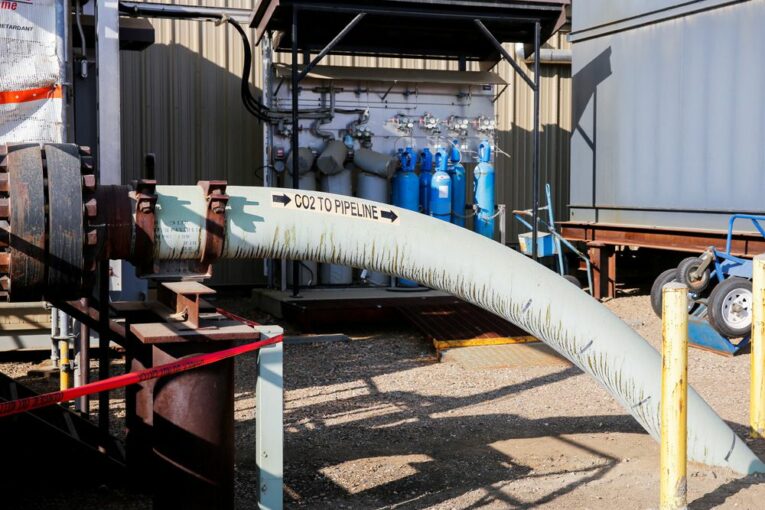
Prime Minister Justin Trudeau unveiled a 50-per-cent tax credit aimed at spurring investment in carbon capture and storage technologies — one the largest and most eagerly anticipated tax code measures outlined in the federal government’s new fiscal plan.
The credit would reduce the large, upfront capital costs involved in constructing carbon capture, utilization and storage (CCUS) projects for heavy emitters, and could potentially have a huge impact on emissions output from the oil and gas, cement, chemicals, manufacturing, and power generation industries.
The refundable investment tax credit for businesses will cover 50 per cent of the cost of equipment to capture CO2 through CCUS projects beginning in 2022, and is expected to cost the federal government $2.6 billion in the first five years of the program — reaching up to $8.6 billion by 2030.
An additional credit of 37.5 per cent would cover equipment for transportation, storage and use of carbon dioxide emissions.
The Trudeau government’s new fiscal plan also includes a 60-per-cent credit for investment in direct air capture technologies to remove carbon from the atmosphere. Direct air capture projects are far less common than CCUS, which is focused on retrofitting fossil fuel-based power and industrial plants to capture emissions at their source.
To prompt businesses to begin building the projects sooner, the federal government said the credits will be cut in half starting in 2031.
The oil and gas sector has been urging Ottawa for months to implement a credit of up to 75 per cent to cover the costs associated with carbon capture, though some provincial governments and business groups had suggested 50 per cent would be sufficient to encourage investment.
“We’ve crunched the numbers to look at what would be an economic model, not just for oil and gas, but for all industries, cement, fertilizer, manufacturing, and (looked at) what’s been done globally,” Tim McMillan, the head of the industry’s largest advocacy group, the Canadian Association of Petroleum Producers (CAPP), said earlier this week.
“We put in a recommendation of 75 per cent (investment tax credit) to enable those projects to go forward.”
Some industry proponents said the size of the credit announced in the 2022 budget means that the economics of many CCUS projects will remain challenging.
“The key for us is 50 per cent will not make all CCUS projects and all opportunities move forward because this is quite expensive to undertake,” said Tristan Goodman, chief executive of the Explorers and Producers Association of Canada. “But it will be constructive and moving in the right direction.”
Conventional oil producers in particular were disappointed with the federal government’s decision to opt against extending the credit to projects that capture carbon dioxide for use in enhanced oil recovery (EOR), a process that involves injecting CO2 into existing oil fields to push trapped oil out of the ground. Industry proponents have argued Canada’s policy should aim to be competitive with a tax credit in the United States, known as 45Q, which allows companies to earn money for carbon capture projects that include EOR.
“We are, in the main, disappointed that CCUS-enhanced oil recovery is not included,” Goodman said. “We think that’s a missed opportunity to actually reduce GHG emissions. The oil is actually going to be produced anyway, so I don’t know why we wouldn’t want to make it economic to produce it at a lower GHG rate.”
A group comprised of six oilsands giants, including Canadian Natural Resources Ltd., Cenovus Energy Inc., ConocoPhillips Canada, Imperial Oil Ltd., MEG Energy and Suncor Energy Inc., known as the Oilsands Pathways to Net Zero alliance, welcomed the announcement Thursday. The group has been lobbying for federal support for their proposed carbon trunkline and sequestration hub in northern Alberta — a project which promises to reduce CO2 emissions by 10 megatonnes per year by 2030.
“It’s a very important step to help Canada achieve its climate goals and ensure that not only our company but the country is the preferred supplier of responsibly produced oil,” MEG Energy CEO Derek Evans said in the interview.
Though Evans acknowledged the federal credit alone may not be sufficient to ensure the entire multi-billion dollar project is built. He said the industry is hopeful the Alberta provincial government will provide further funding. “Hopefully the combination of the two will be sufficient for us to move forward on the entire project,” Evans said.
Alberta’s United Conservative government pledged $30 million earlier this year in funding to kickstart design and engineering work on industrial-scale carbon capture projects in the province. The province has also green-lit further work on six proposed carbon sequestration hubs.
Environmentalists have been largely opposed to extending an investment tax credit for CCUS to the oil and gas sector on the grounds that it could prolong the life of the fossil fuel industry at a time when production should be declining in order to meet Canada’s climate goals. Others have argued that an industry currently awash in profits from surging energy prices can afford to pay for the technology without public investment.
“Today it’s a nice price environment,” said Evans. “In April of 2020 the oil price was $16.55. Last April it was $62. Today it’s $97. We do not make investment decisions based on the current price of oil. This is a 30-year project. We make our investment decisions based on the long term price of oil, and at a $60 (West Texas Intermediate) price, we absolutely need support to kickstart this important initiative.”
• Email: [email protected] | Twitter: mpotkins
You can read more of the news on source
